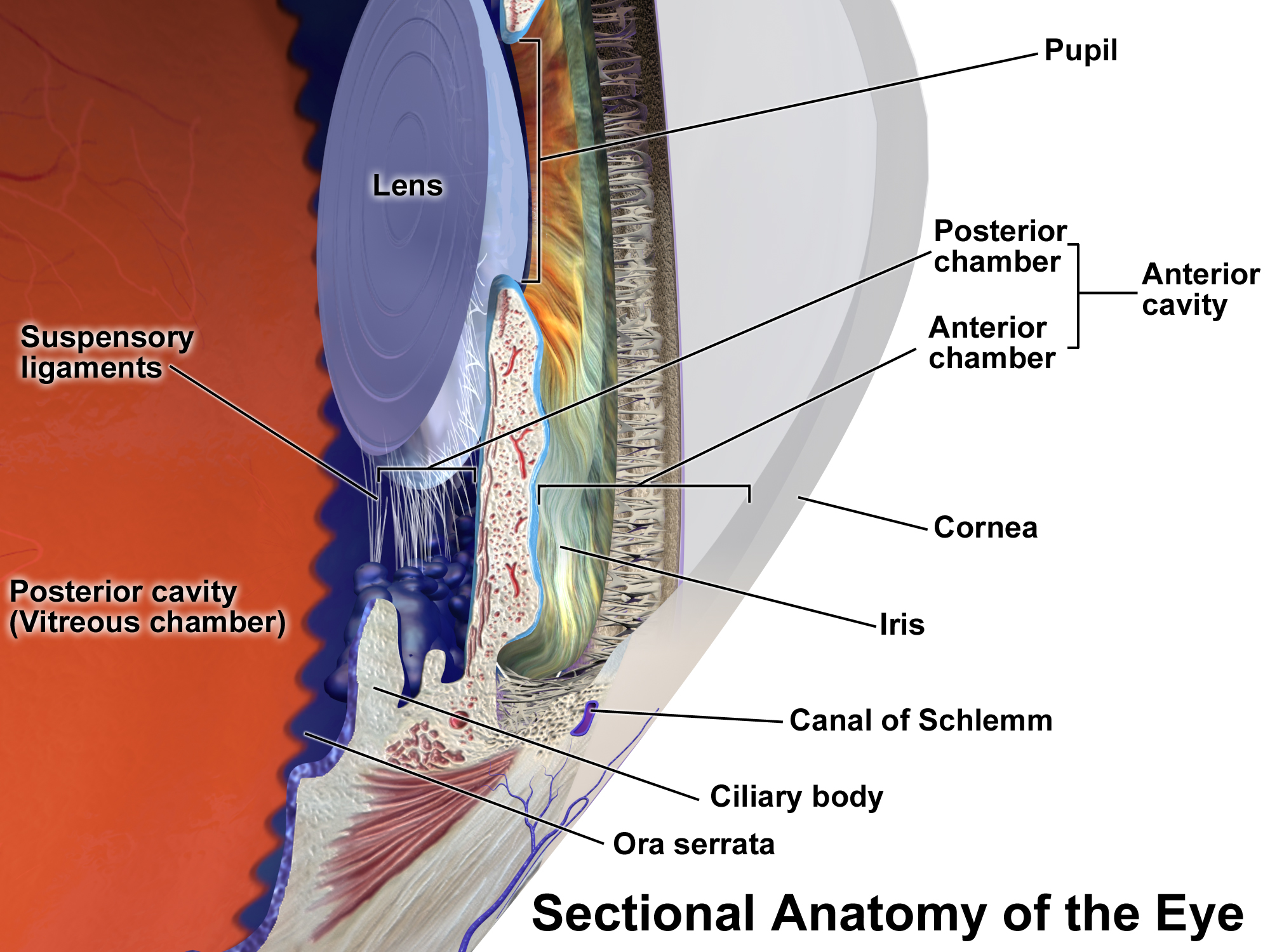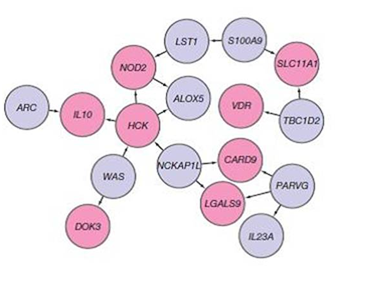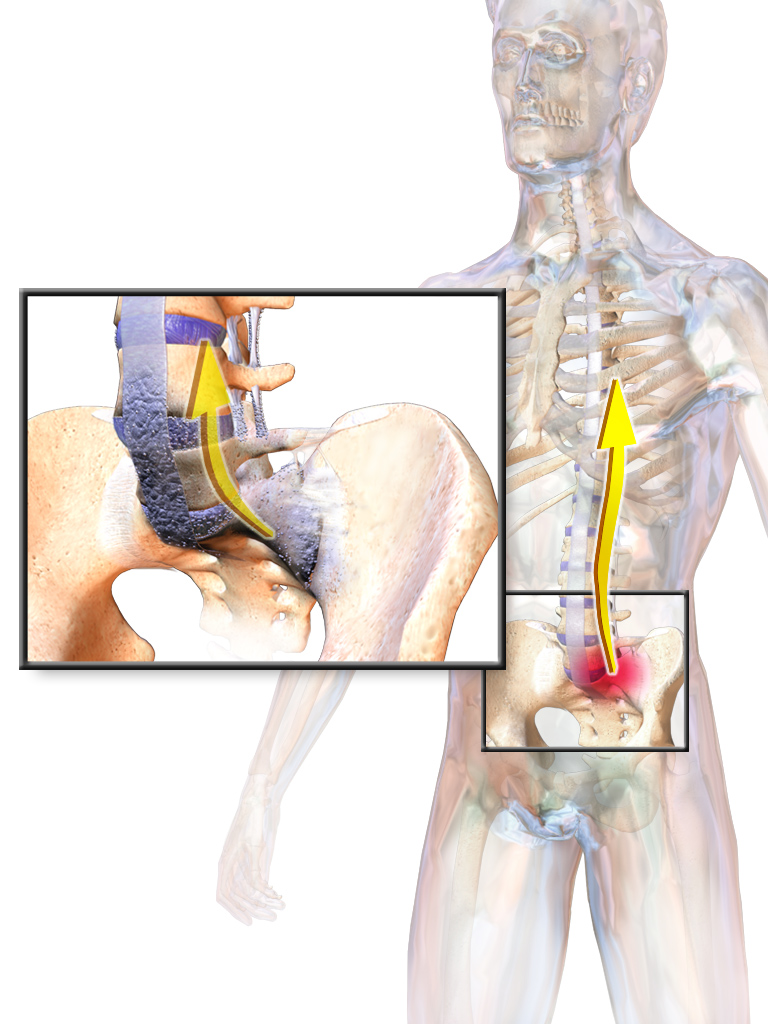|
Spondylarthropathy
Spondyloarthropathy or spondyloarthrosis refers to any joint disease of the vertebral column. As such, it is a class or category of diseases rather than a single, specific entity. It differs from spondylopathy, which is a disease of the vertebra itself, but many conditions involve both spondylopathy and spondyloarthropathy. Spondyloarthropathy with inflammation is called axial spondyloarthritis. In the broadest sense, the term spondyloarthropathy includes joint involvement of vertebral column from any type of joint disease, including rheumatoid arthritis and osteoarthritis, but the term is often used for a specific group of disorders with certain common features, which are often specifically termed seronegative spondylarthropathies. They have an increased incidence of HLA-B27, as well as negative rheumatoid factor and ANA. Enthesopathy is also sometimes present in association with seronegative . Non-vertebral signs and symptoms of degenerative or other not directly infected infl ... [...More Info...] [...Related Items...] OR: [Wikipedia] [Google] [Baidu] |
Joint Disease
An arthropathy is a disease of a joint. Types Arthritis is a form of arthropathy that involves inflammation of one or more joints, while the term arthropathy may be used regardless of whether there is inflammation or not. Joint diseases can be classified as follows: * Arthritis :*Infection, Infectious arthritis ::*Septic arthritis (infectious) ::* Tuberculosis arthritis ::* Reactive arthritis (indirectly) :*Noninfectious arthritis ::*Seronegative spondyloarthropathy: :::*Psoriatic arthritis :::*Ankylosing spondylitis ::*Rheumatoid arthritis:'' :::* Felty's syndrome ::*Juvenile idiopathic arthritis ::* Adult-onset Still's disease ::*Crystal arthropathy :::*Gout :::*Chondrocalcinosis ::*Osteoarthritis * Hemarthrosis (joint bleeding) * Synovitis is the medical term for inflammation of the synovial membrane. * Joint dislocation With ''arthropathy'' in the name * ''Reactive arthropathy'' (M02-M03) is caused by an infection, but not a direct infection of the synovial space. (See also Rea ... [...More Info...] [...Related Items...] OR: [Wikipedia] [Google] [Baidu] |
Lower Back Pain
Low back pain (LBP) or lumbago is a common disorder involving the muscles, nerves, and bones of the back, in between the lower edge of the ribs and the lower fold of the buttocks. Pain can vary from a dull constant ache to a sudden sharp feeling. Low back pain may be classified by duration as acute (pain lasting less than 6 weeks), sub-chronic (6 to 12 weeks), or chronic (more than 12 weeks). The condition may be further classified by the underlying cause as either mechanical, non-mechanical, or referred pain. The symptoms of low back pain usually improve within a few weeks from the time they start, with 40–90% of people recovered by six weeks. In most episodes of low back pain, a specific underlying cause is not identified or even looked for, with the pain believed to be due to mechanical problems such as muscle or joint strain. If the pain does not go away with conservative treatment or if it is accompanied by "red flags" such as unexplained weight loss, fever, or signific ... [...More Info...] [...Related Items...] OR: [Wikipedia] [Google] [Baidu] |
Undifferentiated Spondyloarthropathy
Differentiation may refer to: Business * Differentiation (economics), the process of making a product different from other similar products * Product differentiation, in marketing * Differentiated service, a service that varies with the identity of the consumer or the context in which the service is used Science, technology, and mathematics Biology and medicine * Cellular differentiation, in biology * ''Differentiation'' (journal), a peer-reviewed academic journal covering cell differentiation and cell development * Developmental biology, the study of the process by which animals and plants grow and develop * Differentiation therapy, a cancer treatment in which malignant cells are encouraged to differentiate into more mature forms using pharmacological agents Geology * Igneous differentiation, in geology * Planetary differentiation, in planetary science and geology Social sciences * Differentiation (economics), the process of making a product different from other similar produ ... [...More Info...] [...Related Items...] OR: [Wikipedia] [Google] [Baidu] |
Juvenile Idiopathic Arthritis
Juvenile idiopathic arthritis (JIA) is the most common, chronic rheumatic disease of childhood, affecting approximately one per 1,000 children. ''Juvenile'', in this context, refers to disease onset before 16 years of age, while ''idiopathic'' refers to a condition with no defined cause, and '' arthritis'' is inflammation within the joint. JIA is an autoimmune, noninfective, inflammatory joint disease, the cause of which remains poorly understood. It is characterised by chronic joint inflammation. JIA is a subset of childhood arthritis, but unlike other, more transient forms of childhood arthritis, JIA persists for at least six weeks, and in some children is a lifelong condition. It differs significantly from forms of arthritis commonly seen in adults (osteoarthritis, rheumatoid arthritis), in terms of cause, disease associations, and prognosis. The prognosis for children with JIA has improved dramatically over recent decades, particularly with the introduction of biological the ... [...More Info...] [...Related Items...] OR: [Wikipedia] [Google] [Baidu] |
Anterior Uveitis
Uveitis () is inflammation of the uvea, the pigmented layer of the eye between the inner retina and the outer fibrous layer composed of the sclera and cornea. The uvea consists of the middle layer of pigmented vascular structures of the eye and includes the iris, ciliary body, and choroid. Uveitis is described anatomically, by the part of the eye affected, as anterior, intermediate or posterior, or panuveitic if all parts are involved. Anterior uveitis ( iridocyclytis) is the most common, with the incidence of uveitis overall affecting approximately 1:4500, most commonly those between the ages of 20-60. Symptoms include eye pain, eye redness, floaters and blurred vision, and ophthalmic examination may show dilated ciliary blood vessels and the presence of cells in the anterior chamber. Uveitis may arise spontaneously, have a genetic component, or be associated with an autoimmune disease or infection. While the eye is a relatively protected environment, its immune mechanisms ... [...More Info...] [...Related Items...] OR: [Wikipedia] [Google] [Baidu] |
Psoriatic Arthritis
Psoriatic arthritis is a long-term inflammatory arthritis that occurs in people affected by the autoimmune disease psoriasis. The classic feature of psoriatic arthritis is swelling of entire fingers and toes with a sausage-like appearance. This often happens in association with changes to the nails such as small depressions in the nail (pitting), thickening of the nails, and detachment of the nail from the nailbed. Skin changes consistent with psoriasis (e.g., red, scaly, and itchy plaques) frequently occur before the onset of psoriatic arthritis but psoriatic arthritis can precede the rash in 15% of affected individuals. It is classified as a type of seronegative spondyloarthropathy. Genetics are thought to be strongly involved in the development of psoriatic arthritis. Obesity and certain forms of psoriasis are thought to increase the risk. Psoriatic arthritis affects up to 30% of people with psoriasis and occurs in both children and adults. Approximately 40–50% ... [...More Info...] [...Related Items...] OR: [Wikipedia] [Google] [Baidu] |
Ulcerative Colitis
Ulcerative colitis (UC) is a long-term condition that results in inflammation and ulcers of the colon and rectum. The primary symptoms of active disease are abdominal pain and diarrhea mixed with blood (hematochezia). Weight loss, fever, and anemia may also occur. Often, symptoms come on slowly and can range from mild to severe. Symptoms typically occur intermittently with periods of no symptoms between flares. Complications may include abnormal dilation of the colon (megacolon), inflammation of the eye, joints, or liver, and colon cancer. The cause of UC is unknown. Theories involve immune system dysfunction, genetics, changes in the normal gut bacteria, and environmental factors. Rates tend to be higher in the developed world with some proposing this to be the result of less exposure to intestinal infections, or to a Western diet and lifestyle. The removal of the appendix at an early age may be protective. Diagnosis is typically by colonoscopy with tissue biopsies. It is ... [...More Info...] [...Related Items...] OR: [Wikipedia] [Google] [Baidu] |
Crohn's Disease
Crohn's disease is a type of inflammatory bowel disease (IBD) that may affect any segment of the gastrointestinal tract. Symptoms often include abdominal pain, diarrhea (which may be bloody if inflammation is severe), fever, abdominal distension, and weight loss. Complications outside of the gastrointestinal tract may include anemia, skin rashes, arthritis, inflammation of the eye, and fatigue. The skin rashes may be due to infections as well as pyoderma gangrenosum or erythema nodosum. Bowel obstruction may occur as a complication of chronic inflammation, and those with the disease are at greater risk of colon cancer and small bowel cancer. While the precise causes of Crohn's disease (CD) are unknown, it is believed to be caused by a combination of environmental, immune, and bacterial factors in genetically susceptible individuals. It results in a chronic inflammatory disorder, in which the body's immune system defends the gastrointestinal tract, possibly targeting microbial ... [...More Info...] [...Related Items...] OR: [Wikipedia] [Google] [Baidu] |
Inflammatory Bowel Disease
Inflammatory bowel disease (IBD) is a group of inflammation, inflammatory conditions of the colon (anatomy), colon and small intestine, Crohn's disease and ulcerative colitis being the principal types. Crohn's disease affects the small intestine and large intestine, as well as the mouth, esophagus, stomach and the anus, whereas ulcerative colitis primarily affects the colon and the rectum. IBD also occurs in dogs and is thought to arise from a combination of host genetics, intestinal microenvironment, environmental components and the immune system. There is an ongoing discussion, however, that the term "chronic enteropathy" might be better to use than "inflammatory bowel disease" in dogs because it differs from IBD in humans in how the dogs respond to treatment. For example, many dogs respond to only dietary changes compared to humans with IBD, who often need Immunosuppression, immunosuppressive treatment. Some dogs may also need immunosuppressant or antibiotic treatment when dieta ... [...More Info...] [...Related Items...] OR: [Wikipedia] [Google] [Baidu] |
Enteropathic Arthropathy
Enteropathic arthropathy or enteropathic arthritis refers to acute or subacute arthritis in association with, or as a reaction to, an enteric (usually colonic) inflammatory condition. Causes and associations * Reactive arthritis (Reactive to enteric infection) * Spondyloarthropathies associated with inflammatory bowel disease (Crohn's disease and ulcerative colitis) * Malabsorption related: :*Intestinal bypass ( jejunoileal) :*Celiac disease :*Whipple's disease * Collagenous colitis Note that reactive arthritis can also occur secondary to urethral infection. In that case, the term enteropathic arthropathy would not be used. See also *Enteropathy *Arthropathy An arthropathy is a disease of a joint. Types Arthritis is a form of arthropathy that involves inflammation of one or more joints, while the term arthropathy may be used regardless of whether there is inflammation or not. Joint diseases can be cla ... References {{Diseases of the musculoskeletal system and connective tis ... [...More Info...] [...Related Items...] OR: [Wikipedia] [Google] [Baidu] |
Reactive Arthritis
Reactive arthritis, also known as Reiter's syndrome, is a form of inflammatory arthritis that develops in response to an infection in another part of the body (cross-reactivity). Coming into contact with bacteria and developing an infection can trigger the disease. By the time the patient presents with symptoms, often the "trigger" infection has been cured or is in remission in chronic cases, thus making determination of the initial cause difficult. The arthritis often is coupled with other characteristic symptoms; this has been called Reiter's syndrome, Reiter's disease or Reiter's arthritis. The term "reactive arthritis" is increasingly used as a substitute for this designation because of Hans Reiter's war crimes with the Nazi Party. The manifestations of reactive arthritis include the following triad of symptoms: an inflammatory arthritis of large joints, inflammation of the eyes in the form of conjunctivitis or uveitis, and urethritis in men or cervicitis in women. Arthrit ... [...More Info...] [...Related Items...] OR: [Wikipedia] [Google] [Baidu] |
Ankylosing Spondylitis
Ankylosing spondylitis (AS) is a type of arthritis characterized by long-term inflammation of the joints of the spine typically where the spine joins the pelvis. Occasionally areas affected may include other joints such as the shoulders or hips, eye and bowel problems may occur as well as back pain. Joint mobility in the affected areas generally worsens over time. Although the cause of ankylosing spondylitis is unknown, it is believed to involve a combination of genetic and environmental factors. More than 85% of those affected in the UK have a specific human leukocyte antigen known as the HLA-B27 antigen. The underlying mechanism is believed to be autoimmune or autoinflammatory. Diagnosis is typically based on the symptoms with support from medical imaging and blood tests. AS is a type of seronegative spondyloarthropathy, meaning that tests show no presence of rheumatoid factor (RF) antibodies. There is no known cure for AS. Treatments may include medication, exercise, ... [...More Info...] [...Related Items...] OR: [Wikipedia] [Google] [Baidu] |






